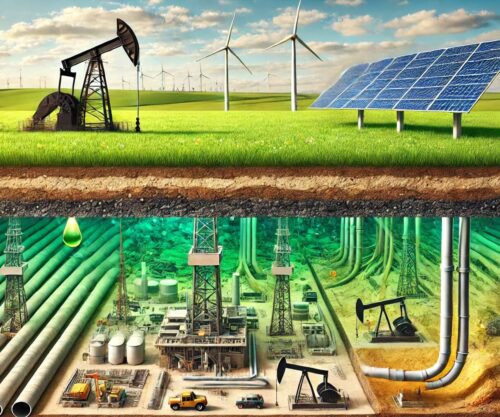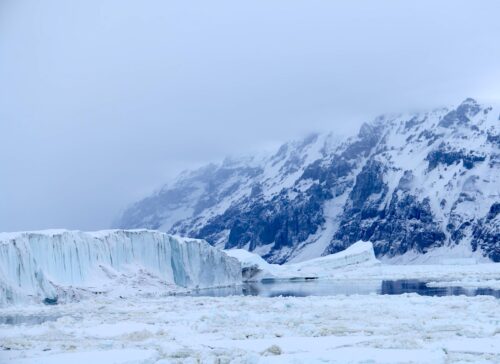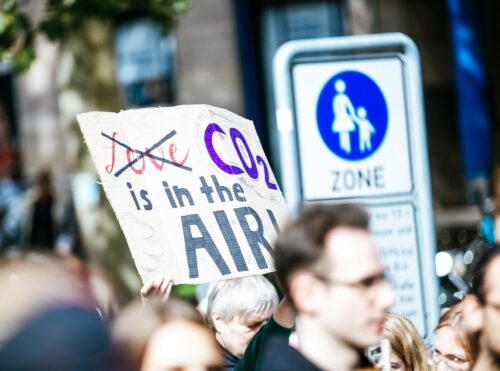 Is Facebook now an expert on polar bear conservation status? Apparently, they have decreed themselves the last word for online content.
Is Facebook now an expert on polar bear conservation status? Apparently, they have decreed themselves the last word for online content.
There is a plan afoot to label anything that says polar bears are not being harmed by recent sea ice declines as ‘disinformation’ – but on whose authority?
A new section of the Climate Science Information Center, launching alongside the labeling trial, debunks common myths such as the false claim that polar bear populations are not suffering due to global heating, or the widespread belief that excess carbon emissions help plant life.
Facebook is working with climate communication experts from around the world, including at the University of Cambridge, to produce the content.
Ah, they’re consulting ‘climate communication experts‘! Those experts surely must be up on all the latest papers and not trusting the word of obviously biased conservations organizations like the WWF or PBI whose real reason for existence is the generation of as much money in donations as possible?
The peer-reviewed literature supports the claim that polar bears are currently thriving despite recent ice declines – especially in the Chukchi and Barents Seas – regardless of what computer model predictions say about what might happen in the future.
This is a fact, not a ‘myth’. See my paper from 2017 and my 2019 book for most of the citations (Crockford 2017, 2019) and others in the reference list below. Check them out yourself before you believe Facebook.
Ask me for any paper you’d like to see via the ‘contact me’ form and I’ll send it along. Also, look for my State of the Polar Bear Report 2020 next week.
The polar bear has two features that mark it as a thriving species: it’s as wide-spread across the Arctic as it was hundreds of years ago and there has not been a sustained, statistically significant decline in numbers in any of the 19 official subpopulations.
Modest declines in abundance for Western and Southern Hudson Bay documented in 2016 were not statistically significant and have almost certainly been reversed since then.
That’s because the last four years have been especially good for Hudson Bay bears: in 2020, most Western Hudson Bay bears left for the newly-formed ice as early in the autumn as they did in the 1980s – for the fourth year in a row – and sea ice breakup in spring was also like the 1980s for the second year in a row.
Southern Hudson Bay bears experienced virtually identical conditions. The number of bear problems in Churchill, Manitoba, which self-identifies as the ‘Polar Bear Capital of the World’, was the lowest in years.
Bears that came ashore in mid-to-late August and left in November would have spent only three months on land – about one month less than most bears did in the 1980s and two months less than bears did in the early 2000s (Castro de la Guardia et al 2017).
The last four years at least have been very similar – so it’s no wonder any of this information has been made available in the peer-reviewed literature.
It’s not just these Canadian bears that have been thriving: virtually all polar bears across the Arctic have been in excellent condition in recent years. Photos of fat bears are the ‘new normal’.
They’ve had an abundance of fat seal pups to eat in the spring due in large part to increased primary productivity.
According to NOAA scientists, the summer growth of plankton in the Arctic has increased since 2002 because of longer ice-free periods, especially in the Russian Arctic, the Barents Sea, and Hudson Bay.
Due to especially low ice levels in 2020, plankton blooms hit record highs in August (see photo below). More abundant plankton benefits the entire Arctic food chain: more fish means fatter seal pups and well-fed polar bears.
This goes a long way towards explaining why polar bears doing so well in areas like the Chukchi and Barents Seas where profound summer sea ice losses have occurred in recent years.
However, none of these recent facts were taken into account for the 2020 computer model that predicted the near-extinction of the species by 2100 and minimal cub survival for Southern Hudson Bay bears before 2030.
This pessimistic model’s primary assumption was that historical data from Western Hudson Bay polar bears could be used as a proxy to predict how all other bear populations across the Arctic would respond to various predicted declines in summer ice coverage.
Unfortunately, the model also depended upon the scientifically discredited and implausible ‘worst case’ climate scenario (‘RCP8.5’) to arrive at its dystopian vision of future sea ice conditions.
As a consequence, this new prediction of polar bear extinction is even less worthy of serious consideration than the failed prediction polar bear specialists developed in 2007.
We now know that polar bears have generally benefitted from much less summer sea ice than was available in the 1980s and rather than declining continuously, September sea ice levels have been rather stable since 2007 (see graph below, from US NSIDC).

Sadly, the facts indicating that polar bears are thriving across the Arctic have been routinely pushed aside in favor of an ominous prophetic narrative because it supports the ‘climate change emergency’ rhetoric.
“Trust the science” is meaningless if model outputs based on faulty assumptions are considered the evidence and if scientists display obvious biases, as the IUCN Polar Bear Specialist Group does when it ignores a massive increase in population numbers that were not statistically significant, as they did for Barents Sea bears, but adopts the new number if it’s not statistically significant but shows a slight decline as they did for Western Hudson Bay.
This is why I do what I do – someone needs to keep the public abreast of recent literature and on-the-ground developments that don’t conform to the climate emergency narrative and to call out false statements made by polar bear specialists with an agenda.
There is currently no climate emergency for polar bears, despite what computer models suggest might happen decades from now.
REFERENCES
Aars, J. 2018. Population changes in polar bears: protected, but quickly losing habitat. Fram Forum Newsletter 2018. Fram Centre, Tromso. Download pdf here (32 Mb).
Atwood, T.C., Bromaghin, J.F., Patil, V.P., Durner, G.M., Douglas, D.C., and Simac, K.S., 2020. Analyses on subpopulation abundance and the annual number of maternal dens for the U.S. Fish and Wildlife Service on polar bears (Ursus maritimus) in the southern Beaufort Sea, Alaska: U.S. Geological Survey Open-File Report 2020-1087. https://doi.org/10.3133/ofr20201087. pdf here.
Castro de la Guardia, L., Myers, P.G., Derocher, A.E., Lunn, N.J., Terwisscha van Scheltinga, A.D. 2017. Sea ice cycle in western Hudson Bay, Canada, from a polar bear perspective. Marine Ecology Progress Series 564: 225–233. http://www.int-res.com/abstracts/meps/v564/p225-233/
Coupel, P., Michel, C. and Devred, E. 2019. Case study: The Ocean in Bloom. In-State of Canada’s Arctic Seas, Niemi, A., Ferguson, S., Hedges, K., Melling, H., Michel, C., et al. 2019. Canadian Technical Report Fisheries and Aquatic Sciences 3344.
Crawford, J.A., Quakenbush, L.T. and Citta, J.J. 2015. A comparison of ringed and bearded seal diet, condition, and productivity between historical (1975–1984) and recent (2003–2012) periods in the Alaskan Bering and Chukchi seas. Progress in Oceanography 136:133-150.
Crockford, S.J. 2017. Testing the hypothesis that routine sea ice coverage of 3-5 mkm2 results in a greater than 30% decline in the population size of polar bears (Ursus maritimus). PeerJ Preprints 19 January 2017. Doi: 10.7287/peer.preprints.2737v1 Open access. https://peerj.com/preprints/2737/
Crockford, S.J. 2019. The Polar Bear Catastrophe That Never Happened. Global Warming Policy Foundation, London. Available in paperback and ebook formats. Crockford, S.J. 2020. State of the Polar Bear Report 2019. Global Warming Policy Foundation Report 39, London. pdf here.
Dyck, M., Regehr, E.V. and Ware, J.V. 2020. Assessment of Abundance for the Gulf of Boothia Polar Bear Subpopulation Using Genetic Mark-Recapture. Final Report, Government of Nunavut, Department of Environment, Iglulik. 12 June 2020. Pdf here.
Frey, K.E., Comiso, J.C., Cooper, L.W., Grebmeier, J.M. and Stock, L.V. 2020. Arctic Ocean primary productivity: the response of marine algae to climate warming and sea ice decline. 2020 Arctic Report Card.NOAA. DOI: 10.25923/vtdn-2198 https://arctic.noaa.gov/Report-Card/Report-Card-2020/ArtMID/7975/ArticleID/900/Arctic-Ocean-Primary-Productivity-The-Response-of-Marine-Algae-to-Climate-Warming-and-Sea-Ice-Decline
George, J.C., Moore, S.E. and Thewissen, J.G.M. 2020. Bowhead whales: recent insights into their biology, status, and resilience. 2020 Arctic Report Card, NOAA. DOI: 10.25923/cppm-n265 https://arctic.noaa.gov/Report-Card/Report-Card-2020/ArtMID/7975/ArticleID/905/Bowhead-Whales-Recent-Insights-into-Their-Biology-Status-and-Resilience
Lippold, A., Bourgeon, S., Aars, J., Andersen, M., Polder, A., Lyche, J.L., Bytingsvik, J., Jenssen, B.M., Derocher, A.E., Welker, J.M. and Routti, H. 2019. Temporal trends of persistent organic pollutants in Barents Sea polar bears (Ursus maritimus) in relation to changes in feeding habits and body condition. Environmental Science and Technology 53(2):984-995.
Lowry, L. 1985. “Pacific Walrus – Boom or Bust?” Alaska Fish & Game Magazine July/August: 2-5. pdf here.
MacCracken, J.G., Beatty, W.S., Garlich-Miller, J.L., Kissling, M.L and Snyder, J.A. 2017. Final Species Status Assessment for the Pacific Walrus (Odobenus rosmarus divergens), May 2017 (Version 1.0). US Fish & Wildlife Service, Anchorage, AK. Pdf here (8.6 MB).
Perovich, D., Meier, W., Tschudi, M., Hendricks, S., Petty, A.A., Divine, D., Farrell, S., Gerland, S., Haas, C., Kaleschke, L., Pavlova, O., Ricker, R., Tian-Kunze, X., Webster, M. and Wood, K. 2020. Sea ice. 2020 Arctic Report Card, NOAA. https://arctic.noaa.gov/Report-Card/Report-Card-2020/ArtMID/7975/ArticleID/891/Sea-Ice Pdf of entire Arctic Report Card here (12 MB).
Regehr, E.V., Hostetter, N.J., Wilson, R.R., Rode, K.D., St. Martin, M., Converse, S.J. 2018. Integrated population modeling provides the first empirical estimates of vital rates and abundance for polar bears in the Chukchi Sea. Scientific Reports 8 (1) DOI: 10.1038/s41598-018-34824-7 https://www.nature.com/articles/s41598-018-34824-7
Rode, K.D., Regehr, E.V., Douglas, D., Durner, G., Derocher, A.E., Thiemann, G.W., and Budge, S. 2014. Variation in the response of an Arctic top predator experiencing habitat loss: feeding and reproductive ecology of two polar bear populations. Global Change Biology20(1):76-88. http://onlinelibrary.wiley.com/doi/10.1111/gcb.12339/abstract
Rode, K. D., R. R. Wilson, D. C. Douglas, V. Muhlenbruch, T.C. Atwood, E. V. Regehr, E.S. Richardson, N.W. Pilfold, A.E. Derocher, G.M Durner, I. Stirling, S.C. Amstrup, M. S. Martin, A.M. Pagano, and K. Simac. 2018. Spring fasting behavior in a marine apex predator provides an index of ecosystem productivity. Global Change Biology http://onlinelibrary.wiley.com/doi/10.1111/gcb.13933/full
Read more at Polar Bear Science




















I can’t post a link to this on Fakebook, “because of their agreement with the Australian government”.
Sheesh.
Listing Polar Bears as Endanergred was pure Politics not Science the same gose with the Spotted Owl,Marblred Murllet Etc its Politics Not Science the Eco-Freaks use
It is easy to think that climate science is the worst branch of modern pseudo-science, but that would be disrespectful to the achievements of ecology.
Most ecologists have convinced themselves and many, many others that everything is critically endangered. Americans are told that kangaroos are thus, which is true for some smaller species, mostly wallabies. The larger, iconic kangaroos that are routinely used to illustrate their point are doing fine, however. The exceptions are in places like Kangaroo Island where bushfires have ravaged the populations – bushfires that are often exacerbated, not by carbon dioxide, but by environmentalist policies.
The species most often used as an illustration, the eastern grey kangaroo, is most probably more numerous now than it’s ever been. It takes a special sort of disinformation to argue that a species which has increased in numbers during the last two centuries is becoming critically endangered.
It’s not just kangaroos increasing in numbers. Rabbits, deer, camels, brumbies (wild horses), cane toads, and the latest is feral cats. Yup, domestic cats that have ‘gone bush’, their numbers have to be reduced – per “Sydney Morning Herald” a couple of days ago. Oh, and crocodiles are also starting to be a problem.
In the 1950’s New Zealand was overrun with deer. The story was that if you went into a ‘cop shop’ (police station) and told them that you’d burned out the barrel of your rifle shooting deer, they’d probably give you a new rifle, and a bunch of ammunition. “Carry on.”
Saltwater crocodiles were always going to bounce back eventually once a hunting ban came in, to the point where the ban should be repealed.
Populations are not always static, but the best way to see increases is to remove predators and, for salties, that was hunting.
The only predator eastern grey kangaroos have in many areas is a vehicle. Consequently, crash repairers in those areas are doing just fine.
I should add, though, that ‘the tally of roo carcasses on the side of the road should not be seen as a measure of their abundance as a species, rather their critically endangered status’: Chapter One, Ecology for Political Gain.
Oh, ‘and the need to ration car ownership’, but you probably knew that bit already.
“and the need to ration car ownership”
That’s one I hadn’t heard about. I moved to the US in 1970. Last time in Australia was 1995 for six weeks. Rented a small Ford and ran up 8,000k in five weeks.
Part of that – Brisbane to Melbourne. I was passing Canberra, parliament was in session and it was being broadcast. “If the hairy chested gentleman from across the aisle would care to step outside…” I almost ran off the road laughing.